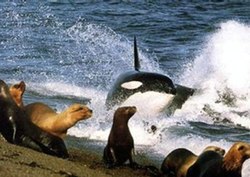New research listening in on whales as they hunt
Bioacoustics, Effects of Noise on Wildlife, Human impacts, Ocean, Science, Seismic Surveys, Shipping Comments Off on New research listening in on whales as they huntTwo new research projects are taking important next steps in understanding the importance of sound, and clear listening, to whales. In recent years, ocean bioacousticians have introduced the concept of “communication space” or “effective listening area” to scientific parlance. This began as a conceptual framework for thinking about how human sounds (especially shipping noise) may reduce the area across which whales can hear and be heard; researchers are now digging into more of the details of how this may actually impact animals in their daily lives. After several recent studies that focused on whales hearing each other (and so framing their results in terms of “communication space”), two new studies are gathering initial data that may inform considerations of the ways whales listen for the presence of prey. While whales can, and do, change some of their communication signals or patterns in order to be better heard by other whales in noisy conditions, there’s no such compensation that can help a whale hear their prey through a wash of noise.
Both of the new studies are taking advantage of acoustic tags to allow scientists to listen in on whales as they are foraging. These tags are about the size of a large cell phone, and are attached to the animals with suction cups; they remain attached for up to 16 hours, then float to the surface for retrieval. While attached, they record all sounds the whales hear and make, as well as logging swimming speed and dive orientation.
 One study is further along, having just published its first results, which confirm that orcas can hunt in near-total darkness, apparently relying only on zeroing in on their prey (in this case, seals) by listening for their mating calls. These orcas do not use echolocation while hunting (other orcas, hunting salmon, do echolocate); they hunt in stealth mode, then dispatch their victims with a swat of their tail flukes. This initial evidence is not totally conclusive; followup studies will confirm that orcas do, indeed, seek out seal sounds. And, this sort of study is but the first step toward quantifying the extent to which ocean noise may limit the range over which orcas can hear seals while hunting.
One study is further along, having just published its first results, which confirm that orcas can hunt in near-total darkness, apparently relying only on zeroing in on their prey (in this case, seals) by listening for their mating calls. These orcas do not use echolocation while hunting (other orcas, hunting salmon, do echolocate); they hunt in stealth mode, then dispatch their victims with a swat of their tail flukes. This initial evidence is not totally conclusive; followup studies will confirm that orcas do, indeed, seek out seal sounds. And, this sort of study is but the first step toward quantifying the extent to which ocean noise may limit the range over which orcas can hear seals while hunting.
The second study will begin next year, and will be putting the acoustic tags on large whales, to see whether they’re using acoustic cues to help locate aggregations of fish. According to Dr. Rochelle Constantine:
“Acoustics within the marine space are really important for many organisms, yet we don’t know a lot about how it drives organisms’ interaction with their environment. We’re interested in looking at how the larger animals use the acoustic environment, particularly for food, and testing the hypothesis that food patches have specific sound signatures.”
She said the sound of “bait balls” of prey, such as schools of fish, could be greatly heightened when a feeding frenzy involving larger fish and seabirds broke out. Dr Constantine said whales had been observed swimming rapidly from over a kilometre away toward prey aggregations, “so we’re very interested to find out if there are specific acoustic cues they home in on”.
This study plans to play recorded sounds of fish aggregations and other prey sounds while the tags on the whales. (I suppose if they happen to get lucky and have an actual feeding event occur while tags are attached, that will be a bonus, but the playback will serve as a reliable testing condition.) This team is also interested in using acoustic tags on large fish and sharks, to explore the ways they may rely on listening, as well.
